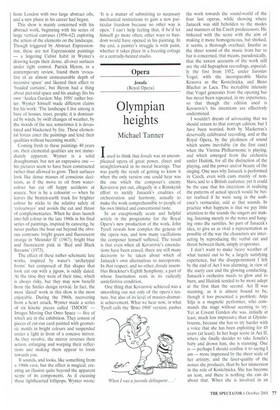Exhibitions 2
Bryan Wynter: A Selected Retrospective 1948-1975 (Tate St Ives. till 2 December)
Elemental forces
Laura Gascoigne
There's a famous story of an exchange between Laurence Olivier and Dustin Hoffman on the set of Marathon Man in the 1970s. Hoffman had been putting himself through physical hell to reach the pitch of nervous exhaustion required by the part, and arrived on set one morning looking suitably rough, to be greeted by Olivier's sympathetic enquiry: 'Have you tried acting'?"
There's a certain school of painters, especially of landscape, who subscribe to a similar 'method' philosophy of art, believing that if they get close enough to the landscape its elemental qualities will somehow rub off on them. This isn't the same thing at all as Turner lashing himself to the mast to observe a particular storm; it means submitting willingly, Gully Jimsonstyle, to the drip-drip effect of long-term union with nature: rain through the roof, damp in the skirting and cold in the bones. What the Actors' Studio in post-war New York was to method-acting, the artists' colony in St Ives was to method-painting, and one of its chief exponents was Bryan Wynter, whose late paintings are now showing at Tate St Ives.
A London boy whose family owned a laundry and who initially trained as a launderer (clothes, not money) in Zurich, Wynter entered the Slade in 1938 and arrived in St Ives in 1945 after spending the war as a conscientious objector. He moved into The Cam, a semi-derelict cottage with no electricity or plumbing high on the moor above Zennor and a mile from the nearest road. There he hunkered down to a career as a landscape painter, producing small, stylised, neo-romantic pictures in monotype and gouache based on direct observation of nature. These little scenes of isolated cottages, with their dark earth colours, brooding atmosphere and Hitchcockian birds, do give a sense of the ruggedness of his existence. But in the mid1950s, a crisis in his painting coincided with the arrival of Abstract Expressionism from America, in the Tate's seismic exhibition of January 1956. That spring Wynter returned from London with two large abstract oils, and a new phase in his career had begun.
This show is mainly concerned with his abstract work, beginning with his series of large vertical canvases (1956-62) exploring the action of the elements on the landscape. Though triggered by Abstract Expressionism, these are not Expressionist paintings — a lingering Cubist habit in Wynter's drawing keeps their dense, all-over surfaces under tight control. Patrick Heron, in a contemporary review, found them 'evocative of an almost unmeasurable depth of recessive space' and likened their effect to 'beaded curtains', but Heron had a thing about pictorial space and his analogy fits his own 'Azalea Garden: May 1956' rather better. Wynter himself made different claims for his work: 'The landscape I live among is bare of houses, trees, people: it is dominated by winds, by swift changes of weather, by the moods of the sea; sometimes it is devastated and blackened by fire. These elemental forces enter the paintings and lend their qualities without becoming motifs.'
Coming fresh to these paintings 40 years on, their elemental qualities are not immediately apparent. Wynter is a solid draughtsman, but not an expressive one — his pictures seem to have been constructed rather than allowed to grow. Their surfaces look like dense masses of conscious decisions, as if the move to oil from watercolour has cut off happy accidents at source. Nor is he a colourist — when he leaves the beaten-earth track for brighter colour he sticks to the relative safety of 'colourways' and avoids the cut and thrust of complementaries. When he does launch into full colour in the late 1960s in his final series of paintings, inspired by canoeing, he never pushes the boat out beyond the obvious contrasts: bright green and fluorescent orange in 'Meander II' (1967); bright blue and fluorescent pink in 'Red and Black Streams' (1973).
The effect of these rather schematic late works, inspired by water's 'archetypal forms' but composed of flat shapes that Look cut out with a jigsaw, is oddly dated. At the time they were of their time, which is always risky, but they may now benefit from the Sixties design revival. In fact, the most 'dated' work in this show is the most enjoyable. During the 1960s, recovering from a heart attack, Wynter made a series of six kinetic pieces called 'IMOOS' — Images Moving Out Onto Space — five of which are in the exhibition. They consist of pieces of cut-out card painted with geometric motifs in bright colours and suspended under a light in front of a concave mirror. As they revolve, the mirror reverses their action, enlarging and warping their reflections and making them appear to loom towards you.
It sounds, and looks, like something from a 1960s rave, but the effect is magical, creating an illusion quite beyond the apparent scope of its components. As if excusing these lighthearted lollipops, Wynter wrote: 'It is a matter of submitting to necessary mechanical restrictions to gain a new particular freedom because no other way is open.' I can't help feeling that, if he'd let himself go more often, other ways to freedom would have opened in his painting. In the end, a painter's struggle is with paint, whether it takes place in a freezing cottage or a centrally-heated studio.



































































































 Previous page
Previous page